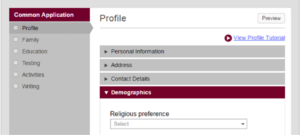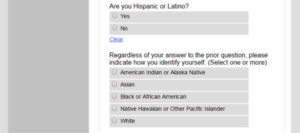A Guide to the ‘Demographics’ Page of the Common Application
With the opening of the Common Application on August 1st, the college admissions season has officially begun. For many students, this period will be characterized by a great deal of time spent with the Common App.
The Common App is utilized by many universities across the nation, and serves as a centralized application database that can help streamline the application process. (Check out our blog post How to Write the Common Application Essays 2017-2018 for the latest essay tips and tricks.)
Going in, many students already know that the Common App will ask them to list the standard components of a college application: grades, test scores, extracurricular activities, and personal statements. However, the Common App actually has several other sections designed to collect more directed information about the applicant.
Among these various components is the “Demographics” page, which we’ll be focusing on in this blog post. You can find the demographics page under the “Profile” section of the Common App.
Demographics Section
This section asks questions about an applicant’s religious preference, veteran status, and race/ethnicity. These may be questions you haven’t thought about answering on your college application. As such, you may not be sure what the purpose of these questions are, how they impact your application, or how you should answer. We’ll be answering these questions and more in this guide to the demographics page of the Common Application.
Why does the Common Application ask for my religion, veteran status, and race/ethnicity?
When you first look at the demographics section, your initial question may be why colleges want this information. Essentially, your answers will be used for demographic purposes. Colleges want to have a record of how many members from each given demographic fill out their specific application.
Chances are you’ve seen a college’s admissions statistics page online at some point. Many schools highlight some demographic information on their applicant pool on their websites, and most of that information is based on what students provide on the Common App (or school specific applications with similar questions). This is useful both for potential applicants and for the colleges themselves.
Additionally, having demographic information on record allows colleges to see which groups are well-represented in their pool and which groups aren’t. This can be especially beneficial when colleges are deciding how they should direct their outreach efforts to potential applicants. For instance, if one group is particularly underrepresented in a given admissions cycle, colleges may make a stronger effort to reach out to potential applicants from that group in the next cycle.
This information, specifically with regards to race and ethnicity, can also be used for affirmative action purposes. Some universities take into account race and ethnicity when evaluating applicants, and this may be one consideration in the holistic admissions process employed by many schools.
Underrepresented minorities (URMs), such as African American, Hispanic/Latino, and Native American students, may be given an extra advantage in admissions. Additionally, white and Asian American students may be held to higher admissions standards. Each school has a slightly different approach to affirmative action, and there’s no way to determine just how much of a role race and ethnicity play across the board. However, affirmative action is one reason why colleges want your demographic information.
Keep in mind that you are not obligated to answer any question in this section. All questions are entirely optional, and whether or not you choose to respond is up to you. You should ultimately do whatever you feel comfortable with.
Will listing my religion hurt my chances of admission?

The first question in the demographics section asks for students to select their religious preference from a drop-down menu. Many different faiths are listed, and students also have the option to select “none” if they feel that best reflects their personal religious preferences.
But will listing your religious preference potentially hurt your application? Most likely not. In fact, by law, public colleges and colleges that receive public funding in any form are not permitted to discriminate for any reason. No matter what religion you choose to list on your Common App, you can rest assured that it will not impact your application to these schools in any way.
The answer is a little different for private colleges. These universities are not bound to the same rules, and thus there is no such law that applies to them in this way. However, generally, there will be no reason for a college to discriminate on the basis of religion.
Indeed, even parochial or faith-based schools often accept applicants from outside the faith. In fact, if you look up the demographic information for most universities, both private and public, you’ll find that many different religions are represented on their campuses. In short, listing your religion is unlikely to hurt your chances of admission in any way.
Does listing my veteran status (or lack thereof) have any impact on my application?

Once you’ve selected a religious preference, the next series of questions focus on veteran status. In the first question, you are asked to list your U.S. Armed forces status. The drop-down menu contains four options:
- Currently Serving. This refers to applicants who are currently service members of the U.S. Armed Forces. This includes applicants who are currently serving the U.S. Armed Forces on active duty and applicants who are on reserves.
- Previously Served. This refers to applicants who are either veterans of the U.S. Armed Forces or who have retired.
- Current Dependent. This refers to applicants who are the dependents of someone currently serving in the U.S. Armed Forces.
- None. This applies to applicants who do not fall under any of the above three categories. Essentially, these are individuals who have no direct connection to the U.S. Armed Forces.
If you select either “current dependent” or “none,” you have no more questions to answer regarding veteran status and have completed this component of the demographics section. You can then move on to answering the question on race/ethnicity, which we’ll discuss later on in this blog post.
However, if you select “currently serving” or “previously served,” you will then be prompted to answer several more questions, including what your anticipated status at the time you enroll in university will be.
You have three options: on active duty U.S. military, veteran of U.S. armed forces, or U.S. Reserves or National Guard. You should answer this question based on what you believe your status will be at the beginning of the next school year. For this admissions cycle, that would be the fall of 2017.
You are then asked to select which branch you served: Army, Marine Corps, Navy, Air Force, or Coast Guard. After that, you are asked to list the time periods during which you served those branches. (You are able to enter up to three different time periods.)
Finally, the last question related to veteran status is whether you ever received an Other Than Honorable Discharge, Bad Conduct Discharge, or Dishonorable Discharge. You should answer this question truthfully, no matter what your response may be. If you would like to discuss the circumstances that led to your discharge in further detail, you can utilize the Additional Information section of the Common Application.
The main reason colleges ask for applicants to provide their veteran status is for demographic and statistical purposes, so that they have an idea of how many veterans are actually applying to their university. Oftentimes, veterans may be underrepresented in certain schools’ pools, and schools may choose to increase their outreach to these groups based on the information they collect. Additionally, veterans are often eligible for certain benefits, financial and otherwise. Thus, it’s helpful for universities to know this during the applications process.
What about race/ethnicity?

The final component in the demographics section asks for students to provide their ethnicity and their race. It may be helpful to first highlight the difference between these two terms, which are often confused and/or used interchangeably. Essentially, ethnicity refers to a cultural group, and race refers to a genetic group. These terms are not mutually exclusive. For instance, your ethnicity can be Hispanic/Latino, and your race could still be white or black.
You also have the option of selecting more than one race, if you so identify. Additionally, if you don’t feel comfortable listing a race in addition to your ethnicity, you are not obligated to do so. As we’ve mentioned before, all questions in this section are entirely optional.
On a related note, you also do not have to list your race if you think it will hurt your chances of admission. If you’d prefer to not answer this question, that is completely acceptable. Ultimately, you can choose to respond to as many or as few of the questions in this section as you choose. While your responses may be helpful to colleges, whether or not you provide them is your choice.
Still have questions about filling out the Common Application? Check out our blog post How to Write the Common Application Essays 2017-2018.
Want help with your college essays to improve your admissions chances? Sign up for your free CollegeVine account and get access to our essay guides and courses. You can also get your essay peer-reviewed and improve your own writing skills by reviewing other students’ essays.





